
Osteochondrosis is a chronic spinal disease in which degenerative and distribution changes occur in vertebrae and intervertebral discs.
About the most important
For a long time, the disease proceeds asymptomatic, it manifests itself with pain, deteriorated sensitivity, restriction of movements and other unpleasant phenomena, when complications have already been formed in the spine.
Important!The main complications of osteochondrosis include the protuberance of intervertebral discs, somerle hernias, spine anquilosis, infringement of the roosers of the spinal nerves and blood vessels.
Osteochondrosis brings a lot of suffering to the patient, significantly worsens the quality of life, often leads to the immobilization of the column and disability.
How to treat osteochondrosis?
Depending on the level of damage to the spine, the prevalence of the degenerative-divophical process, the severity of the disease and the presence of complications, the treatment of osteochondrosis can be conservative or operational.
The osteochondrosis treatment method can only be discussed after an exhaustive examination of the patient.
By identifying the first signs of osteochondrosis, you must consult a neuropathologist or a vertebrologist.
Also in the treatment of osteochondrosis are treated by an exercise therapy, a manual, physiotherapist and, if necessary, an orthopedist, surgeon and a neurosurgeon.
The conservative treatment of osteochondrosis has an integrated approach: several traditional and non -traditional medicine methods are used, such as:
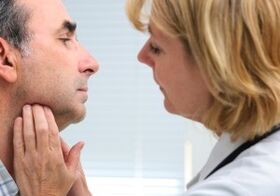
- Pharmacological therapy;
- Medical Gymnastics and Physical Education;
- Isometric kinesotherapy;
- manual therapy;
- reflexology;
- Massage and Autoshaz;
- Physiotherapeutic methods;
- Medical Nutrition;
- Traditional medicine methods.
Pharmacological treatment of osteochondrosis
The medications used for osteochondrosis by type of action can be divided into such groups:
- Drugs to eliminate the inflammatory process in the spine, nerves and paravertebral tissues, non -steroidal anti -inflammatory medications and glucocorticosteroids;
- Project to relieve pain: analgesics and anesthetics;
- Preparations for relaxing spasmodic muscles: muscle relaxants;
- The medications that improve the nutrition of the cartilage tissue of the intervertebral discs, and also protect it from the effects of the negative factors: the condoprotectors;
- Medications that activate metabolism and restore normal blood flow in spine tissues, vitamins, antioxidants;
- Drugs that improve and restore the conductivity of nerve impulses: vitamins B;
- The preparations that relieve the swelling of the roots of the spinal nerves and the paravertebral tissues are diuretic.
Osteochondrosis medicine therapy in the acute period aims to stop pain syndrome.For this purpose, the following drugs are used:

- analgesics;
- Non -steroidal anti -inflammatory medications.The mechanism of action of these medications is found in the blockade of the synthesis of prostaglandins, which trigger the inflammatory process and are responsible for the perception of pain.At the beginning of the therapy, the injection route of the administration of medicines is used, and after a few days they change to an oral administration.The treatment course is 7-10 days;
- Musoriaxantes relieve the spasm of the reflex muscle, thus reducing pain.Drugs are taken inside for 2-3 weeks;
- Paravertebral block that is carried out to eliminate pain.Such blocking effectively relieves pain for several days;
- Glucocortic hormonal medications are a severe artillery medium, have pronounced anti -inflammatory effects and analgesics, even when anti -inflammatory and anesthetical drugs ineffective non -steroids.Drugs are used in short courses to avoid side effects;
- Preparations for local use: ointments, gels, patches with irritating effects and distraction.Local medications may include non -steroid and anesthetic anti -inflammatory drugs.
During the period of remission of osteochondrosis, treatment must be pathogenetic and restoration.Medications used during sinking of osteochondrosis symptoms:
- Condroprotectors are a group of drugs, which include glucosamines and chondroitin sulfate - structural components of the cartilage tissue of vertebrae and intervertebral discs.
- Antioxidants and drugs that improve microcirculation and metabolism.
- B Vitamins V.
- Calcium preparations.
The course of treatment during the period of remission of osteochondrosis with previous medications is 2-3 weeks.
Medical Gymnastics and Physical Education for Osteochondrosis
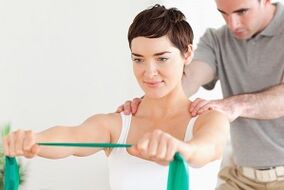
Therapeutic gymnastics and physical education for osteochondrosis develop according to the physical movements of the body that contribute to:
- Reduction of clinical manifestations of osteochondrosis;
- deceleration in degenerative-dystophical processes in the spine;
- Restoration of deteriorated motor functions;
- strengthen the muscles of the back, abdomen, buttocks and hips;
- relaxation of tense muscles of the back and neck;
- expansion of intervertebral cracks and the release of pinched spinal nerves;
- Improvement of blood circulation;
- internal organ work.
So that physical education and therapeutic gymnastics bring the expected effect to comply with the following rules:
- Osteochondrosis exercises should be performed regularly.
- All movements must be soft and slow.
- Breathing should be uniform.
- Follow the pulse frequency.
- In case of discomfort and pain in the muscles and spine, it is necessary to reduce the amplitude and intensity of the movements.
- Gymnastics and physical education can be done at any time of the day.
- To do medical gymnastics and physical education, choose comfortable clothes made of natural cloth.
- Before starting to participate in therapeutic gymnastics and physical education, you must consult with the attending physician.
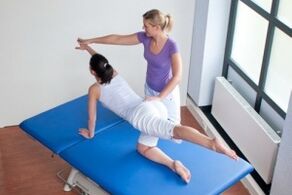
Isometric kinesotherapy is a modern direction of physiotherapy exercises, which consists of performing active and liabilities and respiratory gymnastics.
All kineotherapy exercises are based on anatomical, physiological, biochemical biomechanical aspects.
The main objective of kinesotherapy is to achieve health restoration, preserve it and improve it.
It is better to participate in physiotherapy and gymnastics in specialized hospitals and rehabilitation centers under the control of physiotherapy doctors, who specialize in comprehensive rehabilitation and conservative treatment of osteochondrosis.
But, there are also sets of exercises that can be done at home and even at work.
How can manual therapy with osteochondrosis?
Manual therapy is a method to treat osteochondrosis, which consists of a dosing manual effect on the body to restore the correct configuration of the spine and improve its mobility.
There are contraindications for manual therapy:
- the presence of kidnapping of the hernia of the intervertebral disc;
- myelopathy of the intervertebral disc;
- acute infectious diseases;
- benign and malignant neoplasms;
- hypertension;
- alcohol poisoning;
- inflammatory joint diseases;
- postoperative period;
- The period of supporting a child.
During manipulation manipulations of manual therapy, complications such as damage to ligaments, muscles and vertebrae, hypermobility spine, infraction of intervertebral hernias, rib fractures and vertebrae processes, acute brain disorders.
Therefore, it is important that manual therapy is carried out by a qualified specialist: a doctor in manual therapy, who has experience in this methodology.
Massage for osteochondrosis
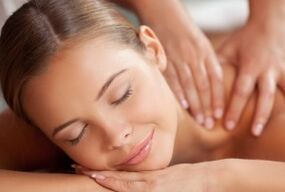
With the help of massage, you can relieve muscle spasm, improve microcirculation, innervation and metabolism in the column, reduce swelling in the affected area, strengthen the back muscles and improve the general condition of the patient.
Indications for massage for osteochondrosis:
- Back muscles hypotrophy;
- osteochondrosis in the remission stage;
- back muscles;
- pain in the field of spinal nerves of the roots;
- circulatory violation in the column;
- Violation of the mobility of the spine.
Contraindications to massage with osteochondrosis:
- Spinal cord compression with intervertebral hernias;
- Decompensated disease of the cardiovascular system;
- bacterial or fungal diseases of the skin;
- Central nervous system diseases (meningitis, encephalitis, cancer, stroke, injury, tuberculosis);
- mental illness in the exacerbation phase;
- respiratory diseases accompanied by respiratory failure;
- fever;
- Musculoskeletic system diseases (malignant and benign neoplasms, infectious diseases, injuries);
- Blood coagulation violation.
Reflexotherapy is an effect on several points of the body that are responsible for a particular organ.
Interesting!You can act on these points for needles, electric shock, magnetic waves, etc.
Using this method, it is possible to improve blood supply to the affected areas of the spine and eliminate the symptoms of the disease.
Physiotherapeutic methods for osteochondrosis
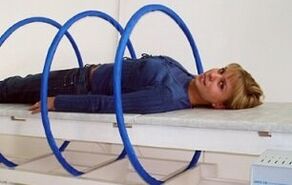
Types of Physiotherapy:
- electrophoresis;
- Magnetotherapy;
- ultrasound therapy;
- vibration massage;
- treatment with ultraviolet radiation;
- Balneotherapy and others.
The effects of physical processing can be the following:
- Standardization of metabolism in affected areas;
- increased body resistance;
- anesthesia;
- Improvement of microcirculation in the spine and paravertebral tissues;
- Edema elimination;
- reduction in the inflammatory process;
- Improvement of the mobility of the spine.
Treatment of osteochondrosis at home
Most patients with osteochondrosis believe they can face the disease independently, taking analgesics with handfuls.
Anti -inflammatory medications and analgesics only relieve the symptoms of osteochondrosis, but do not stop the pathological process in the spine.
Therefore, the treatment of the osteochondrosis of the house is not only the use of analgesics, but a wide range of measures aimed at eliminating the cause of the disease, therapeutic gymnastics, the methods of traditional medicine, the car -master.
The elimination of the causes of osteochondrosis implies the following:
- Healthy diet.In the daily diet, you must reduce the amount of products that increase blood cholesterol: animal fats, chicken eggs, meat broths, pork.
- A healthy lifestyle.Limit the use of alcoholic beverages, coffee, strong tea.Shark from bad habits, for example, smoking.
- A healthy dream will help you provide accessories such as orthopedic mattresses and pillows that create optimal conditions for normal blood circulation during your dream and rest.
- Therapeutic gymnastics and physical education.
- Auto -Massaje.At home, you can rub it yourself, caress and knead your back, neck and neck area.The car -massage will help get rid of headaches, dizziness, improve blood flow in the affected areas of the spine, activate metabolism, relieve fatigue.
- The use of the applicator are special devices that are discs with peaks designed for the treatment of osteochondrosis.
- PhytotherapyYou can take baths with decoctions of several herbs that will help turn off the pain in the back, for example, needles, chamomile, oak bark, spray, calamus, walnut leaves, Valerianas, Lavender and others.They are also charitable in the spine, infusions, tinctures and decoctions to take millennical leaves, celery root, garlic or saber root.
- Burdock leaves and applications, raw potatoes with honey or worm flowers, perfectly eliminate pain in the spine.
- The use of phyto-patas (herbs bags), which adjust the affected area of the spine at night, is the method of Chinese medicine.Biological substances of herbs penetrate through the skin and have a local effect: that distracts and irritating.
- Using a massage bed or a massage chair.
- Using a Chastz necklace with cervical osteochondrosis, which eliminates pain, relieves the spasm of the neck muscles, increases the height of the intervertebral discs and releases the pinched nerves.

Important!There are many different methods to treat osteochondrosis at home, but do not forget the prescriptions of the attending physician.
All traditional and non -traditional treatment methods must be approved by him.
The regular and conscientious implementation of all the doctor's recommendations as a whole will decrease the speed or completely stop the progression of osteochondrosis.


















